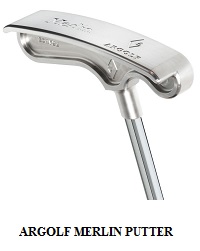Putters and Putting
Dozens of different factors play into a good golf shot, your grip, stance, posture and balance, swing, concentration, and many more. Still, it all starts with the right grip.
|
Putters and Putting
Ok, so there really is no such thing as perfect putting —— but you can get pretty close. Just follow some of these helpful tips:
GRIP and STANCE
 Start with the correct grip. Lightly place your hands on the club. It's not a python you have to squeeze to death before it kills you. Use a very light version of your normal grip, but with the pinky on the club, rather than overlapped or interlocked. When you close your fingers, don't force the club into an angle. Address the ball squarely. Relax. Start with the correct grip. Lightly place your hands on the club. It's not a python you have to squeeze to death before it kills you. Use a very light version of your normal grip, but with the pinky on the club, rather than overlapped or interlocked. When you close your fingers, don't force the club into an angle. Address the ball squarely. Relax.
Place the ball toward the front of your stance, centered between your shoulders. Keep your hands near the top of the grip and focus your eyes directly over the ball. The target line is perpendicular to a power saw that would slice your body in half. This makes it easy to give a natural pendulum stroke along the target line.
If you're right handed, lock in your left hand. Left-handers, lock in the right. The putter face should be perpendicular to the target line, and the ball at the sweetspot, usually. As you lean over, your eyes come into line parallel with the target line. A ball dropped from your nose would land onto that line.
Feet will be generally set no wider than the hips, weight balanced slightly toward the inside of their left heel.
THE BALL
Your ball should be placed roughly between the center of your stance and your left instep. This squares up the path and the clubhead prior to impact. Also, it allows any approach angle to level out enough to for good follow through.
THE PUTTING STROKE
Sweeping strokes are usually positioned slightly left, while a 'tapping' sort of putt should be more centered. Your goal is to strike the ball in the center (the sweetspot), unless you're putting on a downhill slope. Then, try hitting closer to the toe of the putter. This gives slightly less impact force, and lowers the odds of overshooting the hole. A smooth stroke back, followed by a forward motion in the same plane is the ideal. Remember, left hand holds, right hand strokes. (For right-handers.)
PUTTING PRACTICE
If you look closely at most golf balls, you'll notice a line around the 'equator', where there are not dimples. A well constructed ball will be perfectly balanced, with equal weight on any line through the center. But not all are. Good manufacturers, ensure the cover is the same thickness all around, and the core materials a uniform density.
Still, not every ball is perfect. On a practice green (flat, dry, and level), try lining up the line on the ball with the target line toward the hole. Take a few practice putts from 3-6 feet from the hole, then ten feet. Look for any tendency of the ball to veer one way or the other that isn't due to errors in your stance or stroke. (Be honest!)
Now lay down a series of markers (strings or quarters, for example), at different distances from the hole. Try one foot, three feet, six feet, 10 feet, 15 feet. Practice shooting NOT for the hole, but to consistently place the ball within the markers. This will give you a good feel for how hard an impact at what angle rolls the ball how far.
Change the distance between the markers, making them closer together, and repeat until you can put the ball anywhere you want.
See, now you are a perfect putter!
How to Get Paid to Play Golf
Golf Clubs and Accessories
|
You will findwhat you are looking for about golf grip here
Free Immediate Advertising
|

